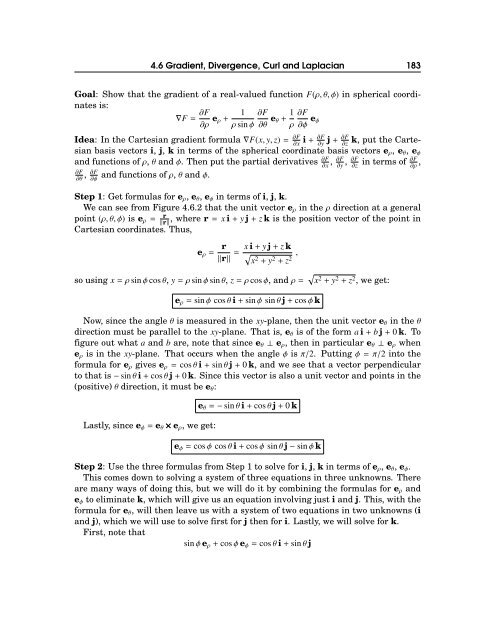Michael Corral: Vector Calculus
Michael Corral: Vector Calculus
Michael Corral: Vector Calculus
Create successful ePaper yourself
Turn your PDF publications into a flip-book with our unique Google optimized e-Paper software.
4.6 Gradient, Divergence, Curl and Laplacian 183<br />
Goal: Show that the gradient of a real-valued function F(ρ,θ,φ) in spherical coordinates<br />
is:<br />
∇F= ∂F<br />
∂ρ e 1 ∂F<br />
ρ+<br />
ρsinφ ∂θ e θ+ 1 ∂F<br />
ρ∂φ e φ<br />
Idea: In the Cartesian gradient formula∇F(x,y,z)= ∂F<br />
∂x i+∂F ∂y j+∂F ∂z<br />
k, put the Cartesian<br />
basis vectors i, j, k in terms of the spherical coordinate basis vectors e ρ , e θ , e φ<br />
and functions ofρ,θandφ. Then put the partial derivatives ∂F<br />
∂x , ∂F<br />
∂y , ∂F ∂F<br />
∂z<br />
in terms of<br />
∂ρ ,<br />
∂F<br />
∂θ , ∂F<br />
∂φ<br />
and functions ofρ,θandφ.<br />
Step 1: Get formulas for e ρ , e θ , e φ in terms of i, j, k.<br />
We can see from Figure 4.6.2 that the unit vector e ρ in theρdirection at a general<br />
point (ρ,θ,φ) is e ρ = r<br />
‖r‖, where r= xi+yj+zk is the position vector of the point in<br />
Cartesian coordinates. Thus,<br />
e ρ = r<br />
‖r‖ = xi+yj+zk √<br />
x 2 +y 2 +z 2,<br />
so using x=ρsinφcosθ, y=ρsinφsinθ, z=ρcosφ, andρ= √ x 2 +y 2 +z 2 , we get:<br />
e ρ = sinφ cosθi+sinφ sinθj+cosφk<br />
Now, since the angleθis measured in the xy-plane, then the unit vector e θ in theθ<br />
direction must be parallel to the xy-plane. That is, e θ is of the form ai+bj+0k. To<br />
figure out what a and b are, note that since e θ ⊥ e ρ , then in particular e θ ⊥ e ρ when<br />
e ρ is in the xy-plane. That occurs when the angleφisπ/2. Puttingφ=π/2 into the<br />
formula for e ρ gives e ρ = cosθi+sinθj+0k, and we see that a vector perpendicular<br />
to that is−sinθi+cosθj+0k. Since this vector is also a unit vector and points in the<br />
(positive)θdirection, it must be e θ :<br />
Lastly, since e φ = e θ ×e ρ , we get:<br />
e θ =−sinθi+cosθj+0k<br />
e φ = cosφ cosθi+cosφ sinθj−sinφk<br />
Step 2: Use the three formulas from Step 1 to solve for i, j, k in terms of e ρ , e θ , e φ .<br />
This comes down to solving a system of three equations in three unknowns. There<br />
are many ways of doing this, but we will do it by combining the formulas for e ρ and<br />
e φ to eliminate k, which will give us an equation involving just i and j. This, with the<br />
formula for e θ , will then leave us with a system of two equations in two unknowns (i<br />
and j), which we will use to solve first for j then for i. Lastly, we will solve for k.<br />
First, note that<br />
sinφe ρ +cosφe φ = cosθi+sinθj








